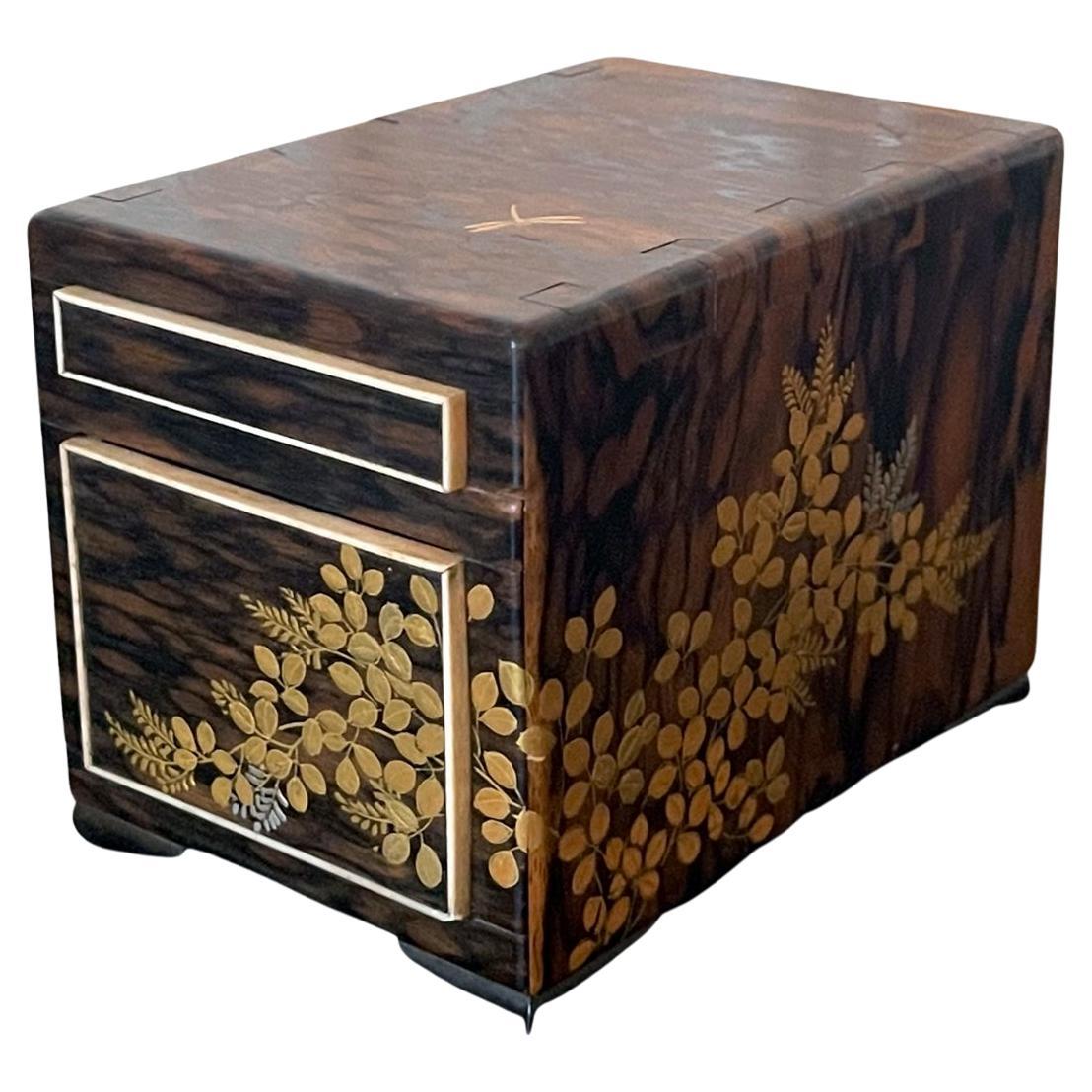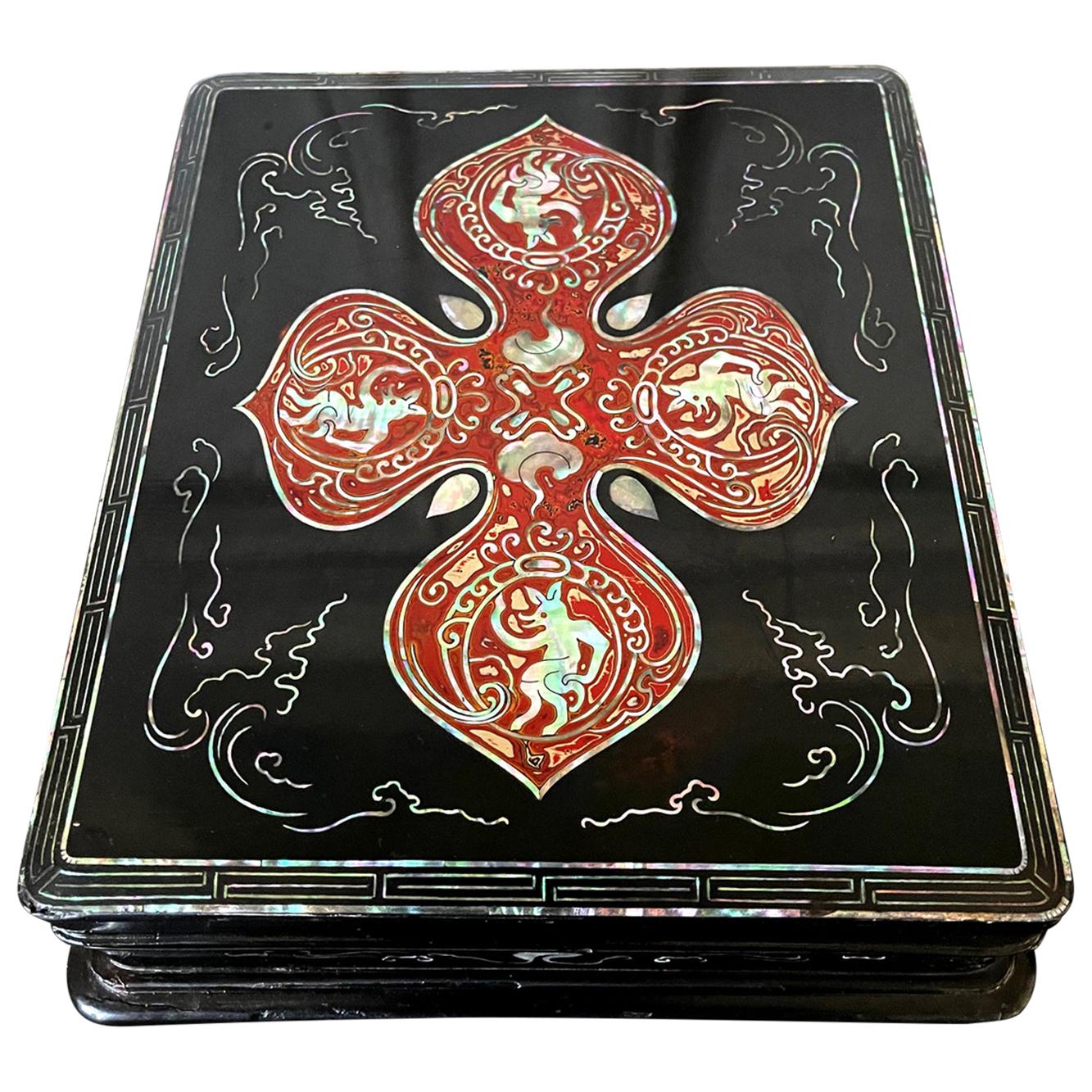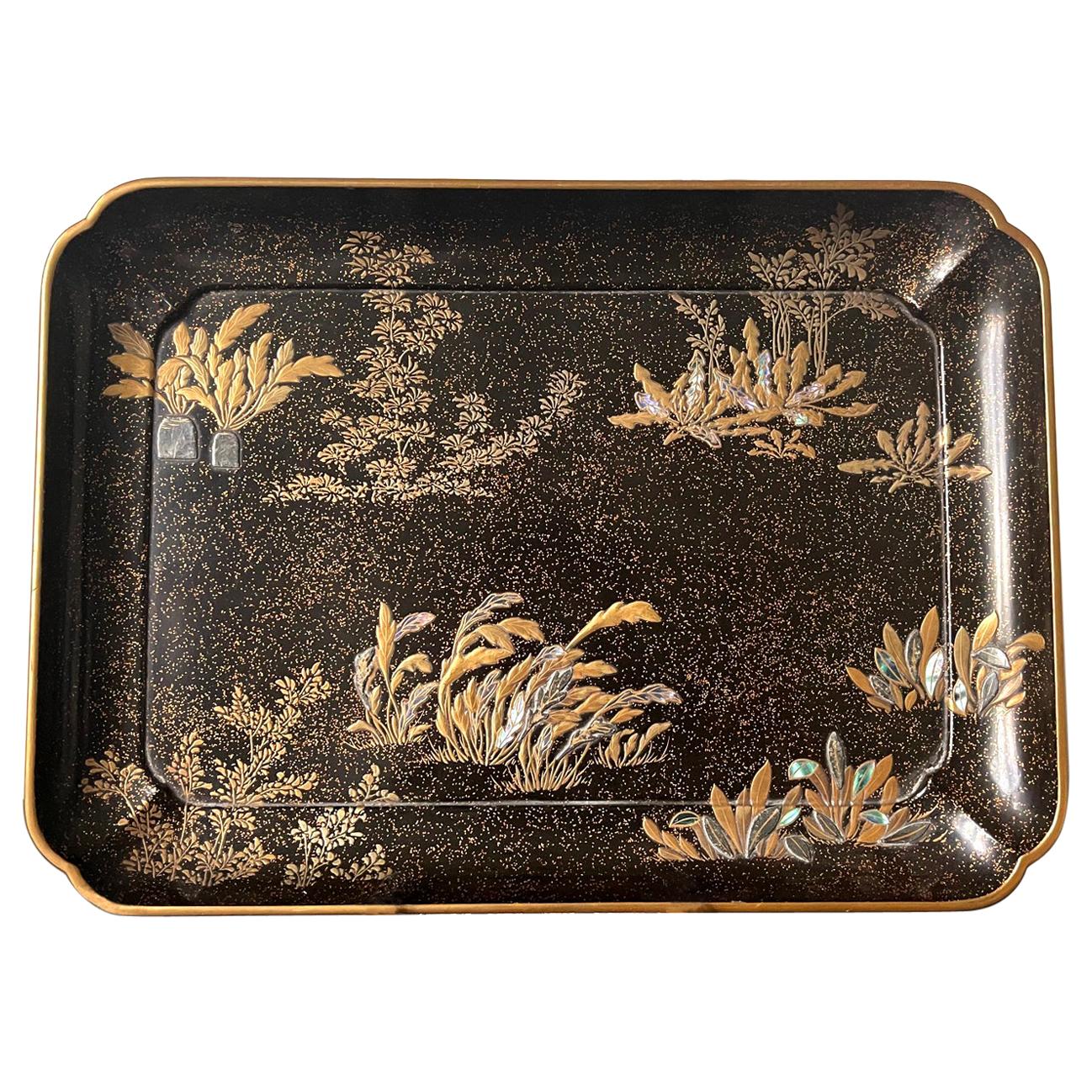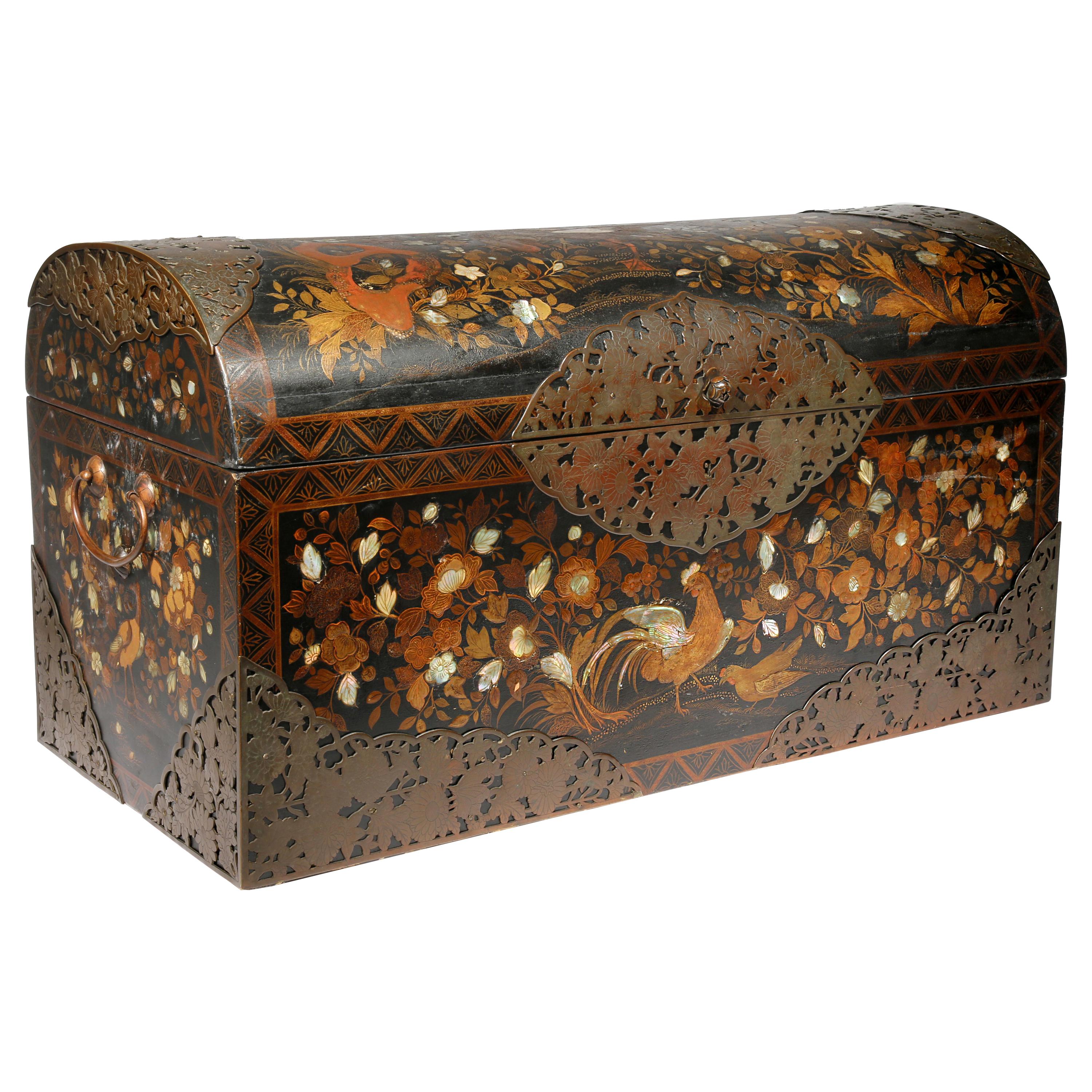Items Similar to Japanese black lacquered sword stand 刀掛け (katana’kake) with raden inlay
Want more images or videos?
Request additional images or videos from the seller
1 of 13
Japanese black lacquered sword stand 刀掛け (katana’kake) with raden inlay
About the Item
Charming black lacquered wooden sword stand (katana’kake), designed for 3 swords, encrusted with beautiful shiny blue/purple mother-of-pearl (raden).
Presenting a stylized depiction of a pine tree branch extending over open water, where leaves drift downstream. In the distance, a pair of sailboats glide beneath a flock of birds. On the reverse side, intricate cherry blossom inlays adorn the surface.
When shipped we will add a certificate of authenticity.
Price including insured shipping.
- Dimensions:Height: 17.29 in (43.9 cm)Width: 17.64 in (44.8 cm)Depth: 7.01 in (17.8 cm)
- Materials and Techniques:
- Place of Origin:
- Period:
- Date of Manufacture:Early Shôwa period (1926-1950)
- Condition:Wear consistent with age and use. The katana’kake is in a very good condition with minimal traces of use conform age. Please look at the photos for a condition reference.
- Seller Location:Amsterdam, NL
- Reference Number:
About the Seller
5.0
Vetted Seller
These experienced sellers undergo a comprehensive evaluation by our team of in-house experts.
Established in 1996
1stDibs seller since 2022
16 sales on 1stDibs
Typical response time: 10 hours
- ShippingRetrieving quote...Ships From: Zwanenburg, Netherlands
- Return PolicyA return for this item may be initiated within 14 days of delivery.
More From This SellerView All
- Japanese Lacquer Natsume 棗 with Kimono Design by Takahashi Masayoshi 高橋正良Located in Amsterdam, NLNice black lacquer tea caddy (natsume) with a colourful hiramaki-e (low-relief design) of a folded yellow kimono with a silver and red chrysanthemum flower pattern. The base with a few golden stylized ‘fog’ streaks. The interior finished with shiny black lacquer. Including original wooden signed and sealed tomobako (storage box) with a leaflet about the artist Takahashi Masayoshi. Who became an independent lacquer artist in 1975 and lives in the town Yamanaka, Ishikawa prefecture. Period: Japan – Late Shôwa period/Heisei period (Late 20th century/Modern). Japanese natsume...Category
Late 20th Century Japanese Lacquer
MaterialsLacquer
- Japanese Ecru Lacquered Natsume 棗 'Tea Caddy' with Maki-E of Carriage WheelsLocated in Amsterdam, NLUncommon ecru lacquer tea caddy (natsume) with a nice golden hiramaki-e (low-relief design) of cart wheels submerged in a wild swirling stream. The design...Category
20th Century Japanese Lacquer
MaterialsGiltwood, Lacquer
- Red lacquer Festival Flag Support abundantly inlaid with mother-of-pearl, JapanLocated in Amsterdam, NLRare museum-worthy Japanese lacquered wooden festival support for a flag. In feudal Japan this kind of supports sat on the back of a horse or ox during pr...Category
Antique 19th Century Japanese Antiquities
MaterialsMetal, Bronze, Copper
- Japanese lacquer oblong storage box by Hiroshi Hayashi 林宏 (1967)By Hiroshi HayashiLocated in Amsterdam, NLAn exceptional, oblong lacquer 3-tiered storage box with cover, reminiscent of a bento box, by Hiroshi Hayashi (1967). Covered in shiny gold and black l...Category
21st Century and Contemporary Japanese Lacquer
MaterialsSilk, Wood, Lacquer
- Japanese lacquer tea caddy 棗 (natsume) showcasing a pine tree forestLocated in Amsterdam, NLPretty lacquer tea caddy (natsume) with refined hiramaki-e (low-relief lacquer design) showcasing a pine tree forest (matsu) at the base of a mountain. Executed in shades of gold lac...Category
Mid-20th Century Japanese Lacquer
MaterialsLacquer
- Pair of Japanese Red Lacquered Hibachi 火鉢 'Fire Bowls' Shaped like FlowersLocated in Amsterdam, NLPair of magnificent hibachi (fire bowls) shaped like chrysanthemum flowers (kiku) and finished with high quality ‘bordeaux red’ lacquer. Each is carved from a solid piece of wood with fine elegant lobes representing the petals. The interior fitted with a copper lining, for the coals, with a nice patina. A pair of hibachi in this colour and with this kind of quality of Material is rare to find! In Japan chrysanthemums are believed to represent happiness, longevity, rejuvenation and nobility. Including original wooden tomobako (storage box). In Western culture these bowls are often used as decorative flower pots...Category
20th Century Japanese Lacquer
MaterialsCopper
You May Also Like
- Beautiful Japanese Lacquered Tray Raden Abalone Shell DecorationLocated in Fukuoka, JPBeautiful Japanese Lacquered Tray with Raden Abalone Shell Decoration This beautiful Japanese lacquered tray is a stunning example of Japanese craftsmanship. It is made of high-qual...Category
20th Century Japanese Lacquer
MaterialsLacquer
- Fine Miniature Japanese Kodansu with Lacquer InlaysLocated in Atlanta, GAA fine Japanese miniature kodansu constructed from Kaki wood (Persimmon) circa 19th century, late Meiji period. With its expressive exotic wood grains and exposed tenon construction,...Category
Antique Late 19th Century Japanese Meiji Lacquer
MaterialsWood
- Fine Japanese Lacquered Inro with Inlays by KajikawaLocated in Atlanta, GAA Japanese four-case lacquer inro by a member of Kajikawa family circa 19th century (late Edo to early Meiji period). It depicts a nocturnal scenery of a meandering stream surrounded by bush clovers, where a full moon is reflected on the water. It was masterfully decorated in gold and silver maki-e using a combination of techniques including takamakie, togidashi and kirigane as well as aogai (abalone shell) inlays. The stream was set between the slightly elevated banks, adding to this piece a already strong three-dimensional composition. The interior was decorated in gold nashiji. It was signed on the bottom "Kajikawa Zou" (made by Kajikawa and a pot seal centered with "Ei" in Kanji. In one of the compartment, there is a katakana mark, appears to be a name, possibly the owner. Kajikawa clan was one of the most famous lacquer artisanal family established in the 17th century. Many well known members over the generations produced lacquer art in a wide range of formats, but two third were signed only with the family name such as this one. It is therefore not possible to pinpoint the exact author of this piece. Provenance: This inro was purchased as lot 349 in Christie's New York sale Japanese...Category
Antique 19th Century Japanese Japonisme Lacquer
MaterialsWood, Lacquer, Shell
- Unusual Japanese Lacquer Inkstone Box with MOP InlaysLocated in Atlanta, GAA Japanese black lacquer box with mother of pearl inlays circa early 20th century, end of Meiji period. It was likely to be used to store inkstone or other scholarly items. The piece displays several interesting characteristics that appear puzzling initially. First, the form is not typical Japanese, but more Chinese and Korean, with its scalloped base. Second, the decoration of MOP inlays also suggests a Korean and Chinese affiliation, especially with the linear borders and the scrolling cloud patters on the sides of the box. These two observations suggest that the box may be from Ryukyu Island instead of Japanese mainland. Third, strikingly in the center of the cover, a bold quarterly floral pattern outlined with MOP was filled with a striking mottled red lacquer using tsugaru nuri...Category
Early 20th Century Japanese Japonisme Lacquer
MaterialsWood, Lacquer
- Japanese Lacquer Tray with Maki-e and Inlay Hara Yoyusai Edo PeriodLocated in Atlanta, GAA lovely Japanese lacquer rectangular lacquer tray with a slightly scalloped corner and four L shape supporting feet by one of the most celebrated lacquer artist active in Edo period Hara Yoyusai (1772-1845). Yoyusai lived in Edo (Tokyo) and worked under the patronage of Lord Matsudaira. He operated a large workshop and had a very prolific output of lacquer objects. Most survived pieces being inro...Category
Antique 19th Century Japanese Japonisme Lacquer
MaterialsWood, Lacquer
- Japanese Namban Lacquer and Inlay Coffer Momoyama PeriodLocated in Atlanta, GAA rare Japanese Namban Lacquer domed coffer circa 1570-1610s of Azuchi-Momoyama to early Edo period. These types of lacquerware were made for export to ...Category
Antique 16th Century Japanese Japonisme Lacquer
MaterialsWood, Lacquer
Recently Viewed
View AllMore Ways To Browse
Cloisonne Opium Set
Edo Period Inro
Burmese Lacquered Bamboo
Burmese Ok
Japanese Gold Silver Lacquer Box
Midcentury Black Lacquer Inlay Wall Art
Peranakan Mirror
Red Wooden Wash Basin
Saji Japan
Sake Storage Container
Stool And Thatch
Tetsuya Yamada
Indian Wood Angels
Korean Chest Shell
Asian Lacquer And Stone
Vintage Japanese Lacquer Tray
Crane Tray
Japanese Antique Sake Set





